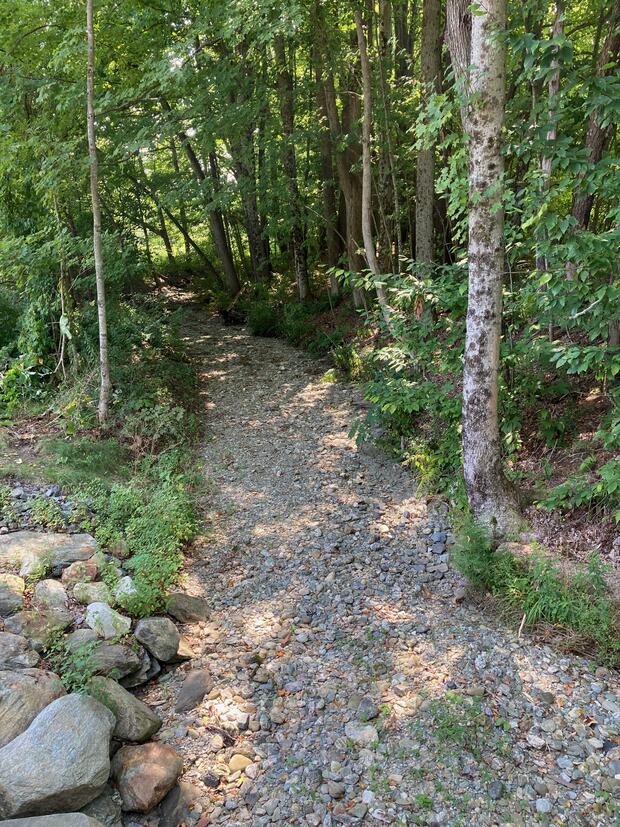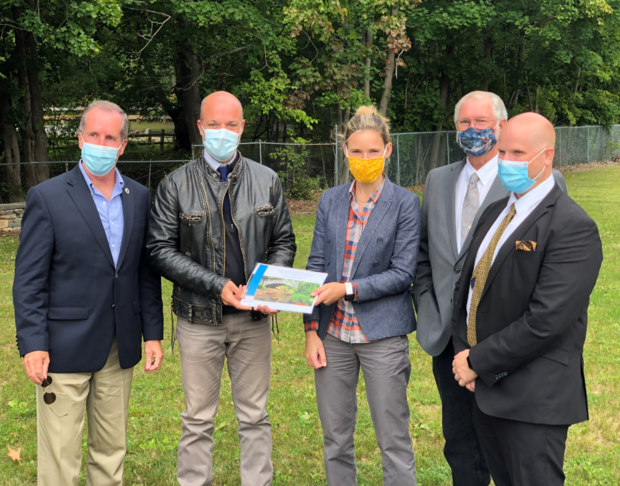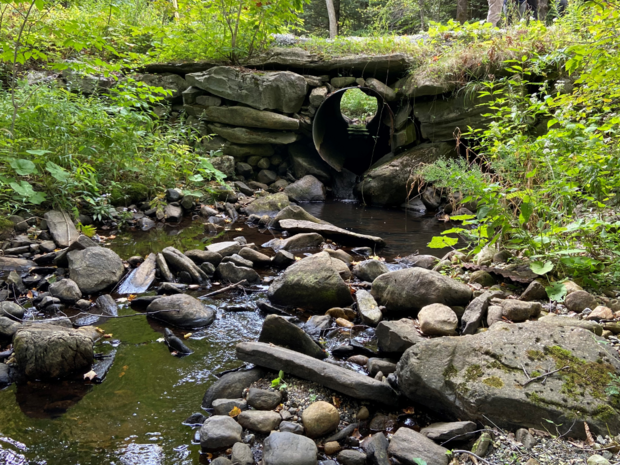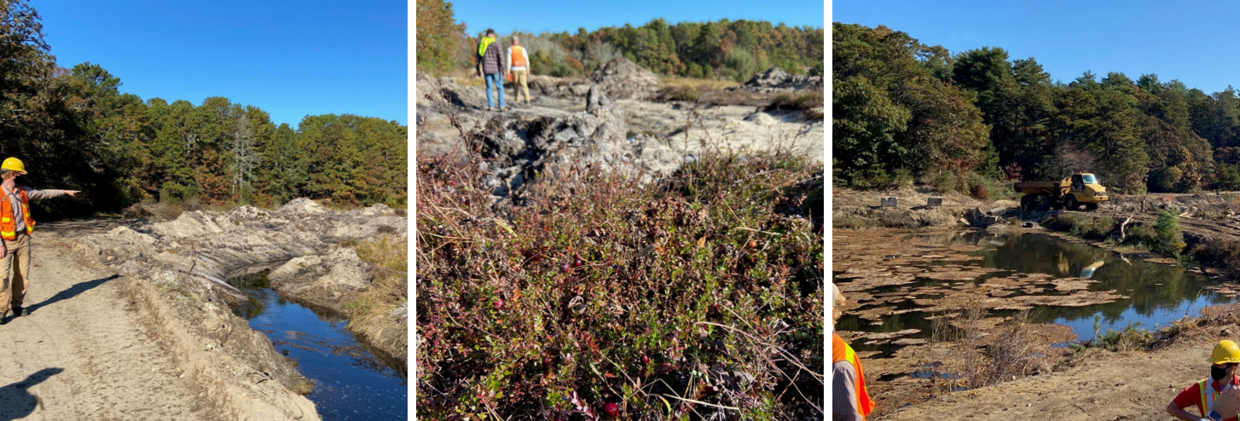Letter from the Director
Friends and colleagues,
Winter is almost here and it's a wonderful time to explore river and wetland restoration sites. Many sites are open to the public and include trails, benches, interpretive signs, and other amenities. With the leaves gone, you can clearly see the natural contours of the restored landscapes. If you visit after a dusting of snow, you’ll also observe wildlife tracks, evidence of nature healing. The winter light makes for beautiful photos, too. Check out our project map to find river and wetland restoration sites near you. Here are a few examples:
- The Eel River Headwaters Preserve in Plymouth, owned by the Town of Plymouth, includes trails, restored wetlands, a dam removal, and a young grove of Atlantic White Cedars.
- Visit MassAudubon’s Canoe Meadows Wildlife Sanctuary, site of the Sackett Brook Restoration Project, for views of dam removal and riparian restoration and several miles of trails.
- The Kent’s Island Tidal Restoration at the Department of Fish and Game’s William Forward Wildlife Management Area in Newbury offers views of the Great Marsh and access to an upland island, once home to Pulitzer Prize winning author John Marquand.
Check the local organization’s home page for any regulations and current COVID-19 guidance.
I’ll see you on the trails!
Beth Lambert, Director
Drought Continues to Impact Massachusetts Waters
Along with the many challenges that have faced the people of Massachusetts this year, residents have also dealt with severe drought conditions throughout the state. Due to nearly six months of below normal rainfall and above normal temperatures, much of the Commonwealth was declared in drought conditions for several months. September conditions in the Southeast region, as well as the Millers and Charles River watersheds were declared in Level 3 – Critical Drought, while the other six regions of Massachusetts were at Level 2 – Significant Drought. Rainfall during October somewhat alleviated these conditions, and increased rainfall in November further improved the drought situation, allowing recent downgrades of all regions of the state to a Level 1 – Mild Drought.
Although drought conditions have improved since the summer, Massachusetts is still facing a drought due to a continued lack of precipitation. Drought conditions have contributed to lower streamflow and groundwater levels throughout the state. Lower-than-normal streamflow translates to less water available to support aquatic habitats for fish and other animals, warmer waters, and degraded water quality. Drought also means less water is available for recreation and human use, including critical supplies for drinking water and firefighting.
How ecosystems and communities respond to drought also depends on how water is managed. The DER Streamflow Program works on several projects to improve low-flow conditions in streams across the state. For instance, the Stony Brook Priority Project team works with dam owners and stakeholders to release water from dams during times of low flow. Real-time data from each of the dammed lakes and downstream rivers in the Stony Brook watershed notifies dam owners when water levels drop below a certain threshold to suggest a release of water. During this year’s drought, several flow releases were performed to benefit downstream habitat.
The DER Streamflow Program has also worked to improve low-flow conditions by partnering with the MA Department of Environmental Protection (MassDEP) and several communities to reduce outdoor water use from lawn watering. Lawn watering typically increases during summer months when streamflows are also lowest– this summer was no exception. To address this strain on water levels in 2017, households in three communities were sent flyers indicating their outdoor water use compared to their neighbors. This pilot program showed reductions in water use by flyer recipients, so the campaign was expanded with MassDEP’s assistance in 2018 and 2019. Summer water savings were significant, resulting in a reduction of 41–128 gallons per household per day on average. Based on these successes, DER and MassDEP developed a toolkit called “Healthy Lawn Happy Summer” for municipalities to implement their own water conservation campaigns based on these past efforts.
Do your part to conserve water, especially during drought conditions! Minimizing your water use both indoors (such as taking shorter showers) or outdoors (such as no longer watering your lawn) can substantially help to take pressure off our already low water supplies.
Culverts & Small Bridges Working Group Report Released
In September, the Massachusetts and Small Bridges Working Group released a new report, titled “Recommendations for Improving the Efficiency of Culvert and Small Bridge Replacement Projects.” This report highlights the safety and environmental challenges presented by over 25,000 road stream crossings across the state and the need for funding and technical assistance for municipalities and partners to address these issues. The report also provides recommendations to address the barriers faced by municipalities to implementing this work.
The report outlined several suggestions for addressing failing and undersized culverts, which can negatively impact communities in many ways, from causing flooding or road failures during storms, to preventing wildlife from accessing necessary habitat. The document highlights the challenges that many municipalities have experienced first-hand. With help from the work of DER and partners, who have been working to help communities replace undersized culverts for well over a decade, towns across the state are replacing undersized culverts with larger, safer, and fish-friendly structures that meet state standards. This report aims to pass this guidance on to a larger audience and was put together based on input from many experienced professionals during the development process, including representatives from DER and the MA Department of Fish and Game (DFG). DFG’s Commissioner Ron Amidon served as Co-Chair for the Culvert and Small Bridges Working Group and DER staff shared their hands-on experience with these kinds of projects. You can learn more about DER’s work to address undersized culverts on the DER website.
These representatives and the rest of the Massachusetts Culverts and Small Bridges Working Group came together to address issues surrounding culvert replacements, as directed by the FY2019 General Appropriations Act. Authored by Senator Adam Hinds and co-sponsored by Senators Anne Gobi, Jamie Eldridge, Jim Welch, and former Senator Don Humason, this bipartisan legislation called on the Executive Office of Energy and Environmental Affairs, in conjunction with the Massachusetts Department of Transportation, to convene this working group. The legislature charged the Culvert and Small Bridges Working Group with developing recommendations for replacing culverts and small bridges more quickly and cost efficiently with climate resilient structures that withstand storms, improve public safety, and protect and restore natural resources.
At an event in Becket in September, the final report was publicly released and presented to Senator Hinds. The release of the Working Group’s report is an exciting achievement and will provide important guidance for this vital work now and into the future. Click here to read the full report.
If you're interested in culverts and would like to receive updates throughout the year, sign up for DER's Culvert Connection newsletter!
Over $800,000 Awarded for Culvert Replacement Projects
Announced in September, DER is providing $806,880 in grant funding to municipalities for culvert replacement projects throughout the state. These awards support projects that strengthen community preparedness for large storms, protect fisheries, wildlife, and river habitats, and promote smart investments in climate-ready infrastructure.
DER awarded twelve projects through its Culvert Replacement Municipal Assistance (CRMA) Grant Program. The CRMA Grant Program helps municipalities replace undersized and deteriorating culverts with crossings that meet improved design standards for fish and wildlife passage, river health, and storm resiliency. The grants also help municipalities deal with the ever-pressing cost of aging road infrastructure.
Replacing undersized culverts can be critical to maintain and support a healthy ecosystem. Structures that meet the Massachusetts Stream Crossing Standards can allow for sediment and larger debris to pass through, maintaining natural stream processes. Passage for fish and wildlife is also paramount to a healthy natural stream and can be essential for access to feeding locations, shelter, and breeding areas. Limiting access to these sites via undersized culverts can have detrimental effects on populations and the ecosystem as a whole.
Undersized culverts can also present a serious risk to public safety. As intense rainstorms become more frequent and severe due to climate change, culvert bottlenecks can cause flood waters to overtop roads, resulting in washouts and road closures. Installing culverts that meet the Stream Crossing Standards allows rivers to flow freely and with lower risk of flood damage. Recent studies have found that culverts designed to meet these standards are often less expensive than in‐kind culvert replacements over the lifespan of the structure. These newly funded projects will work to implement these standards at problematic culverts across the Commonwealth.
Two additional projects were granted funding through DER’s Culvert Replacement Training Initiative to support Culvert Replacement Training Sites. DER provides direct technical assistance and funding to municipalities through the Culvert Replacement Training Initiative to advance the replacement of select municipally owned culverts at strategic locations throughout Massachusetts to provide convenient, centralized learning locations for local road managers.
Click here for a full list of the 14 newly funded projects.
If you're interested in culverts and would like to receive updates throughout the year, sign up for DER's Culvert Connection newsletter!
Project Highlight: Childs River Restoration
Three years ago, DER, the Falmouth Rod & Gun Club, and many other partners began planning the restoration of the Childs River in the Towns of Falmouth and Mashpee. Now, construction of this $1.5 million project is underway.
The Childs River Restoration project site includes a significant portion of the entire Childs River watershed. At the end of the site, the flow of the Childs River is impeded by an earthen dam, a failed fish ladder, and an undersized culvert, which all prevent fish from traveling upstream. These features have also caused a substantial increase in water temperature, preventing coldwater species from migrating and spawning in this location.
The northern portion of the project site is also home to two retired cranberry bogs. These farms are no longer in use and have altered the landscape from the natural wetlands that once occupied the area. Invasive plants have begun to spread and the ditches and layers of sand that were useful for farming are now only preventing the natural vegetation and wetland hydrology from reestablishing itself.
To restore the area to its former natural state, the project aims to restore stream connectivity and reestablish a healthy wetland environment. Construction is now in progress, including removing barriers, dredging impounded sediment and agricultural fill, reconnecting floodplains, re-constructing stream channels, restoring retired cranberry bogs to their natural wetland state, and planting native wetland plants. This work is currently well underway and is expected to benefit a variety of natural species by reestablishing a coldwater habitat and once again allowing wildlife passage and access.
This project is a joint venture of DER, the Falmouth Rod & Gun Club, Sporting, Safety, Conservation, and Education Fund of Falmouth, the Association to Preserve Cape Cod, the U.S. Fish and Wildlife Service, Mashpee National Wildlife Refuge, U.S. Federal Highway Administration, Towns of Falmouth and Mashpee, Falmouth Department of Public Works, Inter-fluve, Inc., Waquoit Bay National Estuarine Research Reserve, Massachusetts Division of Fisheries and Wildlife, Massachusetts Division of Marine Fisheries, Massachusetts Department of Conservation and Recreation, Sea Run Brook Trout Coalition, Friends of the Mashpee National Wildlife Refuge, Falmouth Fund of the Cape Cod Foundation, Trout Unlimited Cape Cod Chapter, Ducks Unlimited, Woods Hole Research Center, Massachusetts Environmental Trust, Southern New England Program/Restore America’s Estuaries, and Rykor Grading (contractor). It is anticipated to result in restored outdoor space for all to enjoy.



